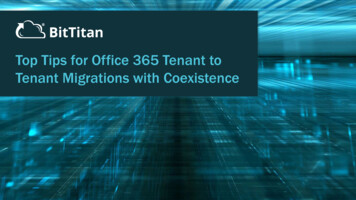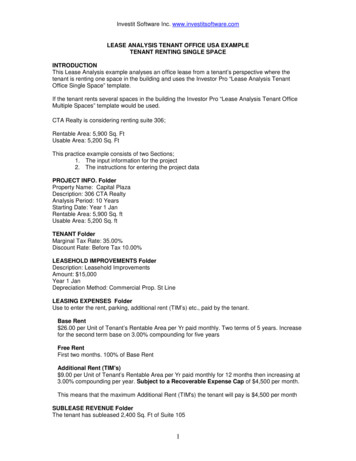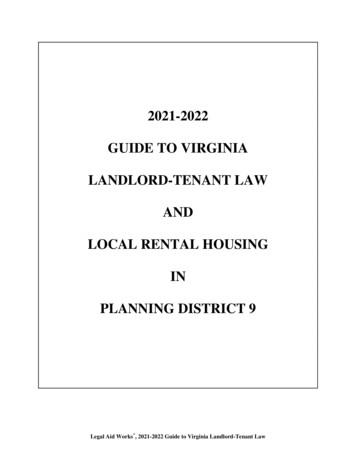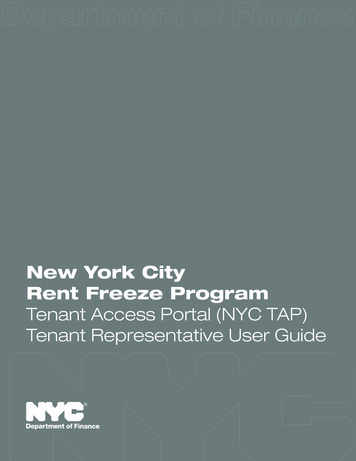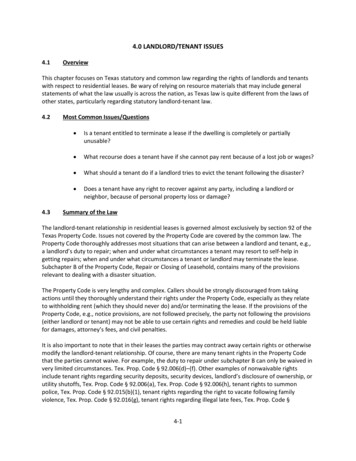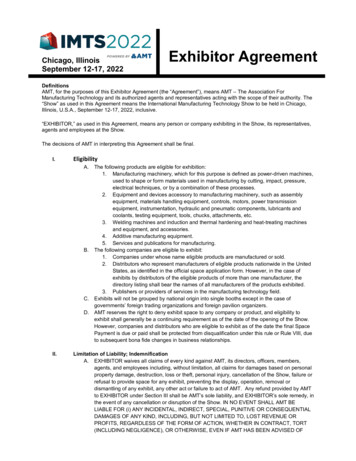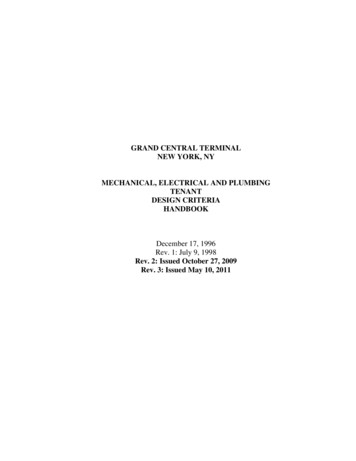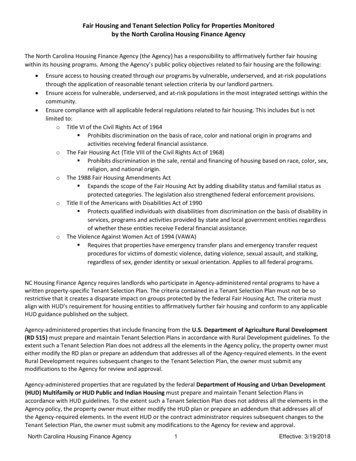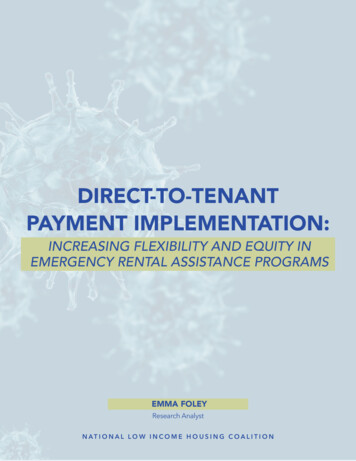
Transcription
DIRECT-TO-TENANTPAYMENT IMPLEMENTATION:INCREASING FLEXIBILITY AND EQUITY INEMERGENCY RENTAL ASSISTANCE PROGRAMSEMMA FOLEYResearch AnalystN AT I O N A L LO W I N C O M E H O U S I N G C OA L I T I O N
INCRXIBILITITY INCREEXIBILITYITYITY INCEALEYUUASING FLQUFAND EQAND EQSINGXIBILITXIBILITTY INCRETY INCREEIIEXIBILLYYEUULAFLFAFQQAND EAND ESINGSINGTY INCRY INCRXIBILITXIBILITTIEEIITY INCEAEALLYYUUQUFFAND EQAND EQSINGSINGDIRECT-TO-TENANT PAYMENT IMPLEMENTATION:INCREASING FLEXIBILITY AND EQUITY IN EMERGENCY RENTAL ASSISTANCE PROGRAMSINTRODUCTIONThe COVID-19 crisis and the accompanying economic fallout has left millions of low-incomerenters unable to pay their rent, putting them at risk of eviction and homelessness. As ofmid-June, nearly six million renter households were behind on rent, accounting for more than14% of all renter households.1 Of households behind on rent, approximately 43.4% reported it wasvery likely or somewhat likely that they would move in the next month due to eviction.To respond to this urgent crisis, Congress passed two pieces of legislation to fund emergencyrental assistance programs, totaling 46.55 billion. The 2021 Consolidated Appropriations Act,passed in December 2020, included 25 billion in urgently needed emergency rental assistance(ERA1) for tenants with low incomes and established the Emergency Rental Assistance program(ERA) administered by the U.S. Department of the Treasury (Treasury). The American RescuePlan Act, enacted in March 2021, provided an additional 21.55 billion for emergency rentalassistance (ERA2).Despite this unprecedented amount of funding, renters in need may still have trouble accessingemergency rental assistance due to a variety of factors. This brief focuses on how programs canprovide payments directly to tenants whose landlords refuse to participate in ERA programs. UsingNLIHC data from detailed program tracking and from interviews with program administrators, thisbrief will outline: 1) ERA policy directives regarding direct-to-tenant assistance; 2) an overview ofthe need for direct-to-tenant payments; and 3) key design features of direct-to-tenant payments.This brief features findings from interviews with four programs implementing direct-to-tenantpayments. These programs represent differing program types and sizes, including a highlycentralized state program (Texas Rent Relief), a decentralized state program (Maine EmergencyRental Assistance), a large local program (Allegheny County Emergency Rental Assistance), and amid-sized local program (Cameron County Emergency Rental Assistance). The two state programsare administered by state agencies, Maine State Housing Authority and the Texas Department ofHousing and Community Affairs, while the local programs are being administered by communitybased organizations, ACTION-Housing in Allegheny County and cdcb come dream. come build.in Cameron County.KEY TAKEAWAYS1Programs should eliminate added burdensome documentation requirements for tenantswho receive funding directly. After meeting the eligibility requirements, tenants shouldnot have to provide onerous documentation about proof of rental payments.2Programs should make clear on their public documents that direct-to-tenant assistanceis available for tenants with landlords who are unwilling to participate. This will preventtenants with uncooperative landlords from assuming they are ineligible and, therefore,not applying.3In addition to direct-to-tenant payments, programs should provide housing stabilityservices to ensure tenants are stably housed after their arrears are paid.1 U.S. Census Bureau. Household Pulse Survey Week 30 (May 12-24) Data Tables.–1–
INCRXIBILITITY INCREEXIBILITYITYITY INCEALEYUUASING FLQUFAND EQAND EQSINGXIBILITXIBILITTY INCRETY INCREEIIEXIBILLYYEUULAFLFAFQQAND EAND ESINGSINGTY INCRY INCRXIBILITXIBILITTIEEIITY INCEAEALLYYUUQUFFAND EQAND EQSINGSINGPOLICY OVERVIEWDirect-to-Tenant Guidance in ERA1 and ERA2Though some program administrators have expressed apprehension about direct-to-tenantpayments, recent guidance from the U.S. Department of Treasury explicitly allows and encouragesthem. According to federal guidance, ERA1 programs are explicitly permitted to provide directto-tenant payments when landlords or utility companies refuse to participate or do not respond toprogram requests. ERA1 programs must conduct reasonable outreach efforts to obtain landlordand utility company cooperation before providing assistance directly to tenants. These outreachefforts can consist of either a single request for participation by mail or three request attemptsby phone, text, or e-mail. Treasury’s revised guidance cuts in half the time to determine whethera landlord elects to participate to 7 days when reaching out by mail and 5 days when reachingout by phone, text, or email before providing direct-to-tenant assistance. Payments can be paidimmediately if the landlord or utility company confirms their non-participation in writing.ERA2 programs must provide direct-to-tenant assistance when a landlord refuses to participate.While ERA1 funds are not bound to these same rules, the White House and Treasury havemade clear that providing direct-to-tenant assistance when landlords refuse to participate is thepreferred policy for ERA1 programs. According to Treasury: “It is unacceptable to allow Americansto suffer eviction or homelessness simply because some landlords are turning down Federal aid ontheir behalf.” In addition, Treasury’s guidance allows ERA2 grantees to provide assistance directlyto tenants without seeking participation of the landlord. An offer of assistance to tenants “first andimmediately” could further speed up the rate at which assistance reaches those most in need.Because grantees are currently focused on spending down ERA1 allocations, this report mostlyconcerns how programs are approaching direct-to-tenant payments under the ERA1 guidance.Allowable Housing Stability Services and Other ExpensesWhile direct-to-tenant assistance is critical to ensure renters’ housing stability when their landlordsrefuse to participate, it can present challenges. Direct-to-tenant assistance makes it unfeasible, forexample, for programs to require that landlords not evict tenants for a prescribed number of daysor not increase the rent. Recent Treasury guidance prohibits landlords from evicting tenants fornonpayment of rent while ERA payments are being made on their behalf and strongly encouragesthat grantees set additional restrictions so landlords cannot evict tenants for 30 to 90 days after theperiod covered by assistance. Most programs require participating landlords to sign a certificationthat they will abide by the program’s terms, but when assistance is provided directly to tenants,there is no possible recourse if landlords do not follow these terms.To ensure renters are protected when they receive assistance directly, programs should consideroffering additional flexibilities and stability services to ensure tenants can remain stably housed.Programs are permitted to use 10% of their funds on housing stability services, which may includeeviction prevention and eviction diversion programs, mediation between landlords and tenants,housing navigators, and other services to help households maintain or obtain housing. Programscan use the other 90% of their funds for direct financial assistance, which includes back andforward rent, utility payments, and other housing expenses. Expenses that fall into the “other”category include relocation assistance, prospective rent, security deposits, and temporary hotelaccommodations. Treasury’s guidance reinforces that providing assistance within these categoriescan help families who have lost, or are at imminent risk of losing, their housing. Programs offeringrobust housing services could increase housing stability for tenants, particularly those who are inprecarious housing situations. For example, providing relocation assistance could help householdswho are experiencing landlord retaliation or hostility. Providing mediation between landlords andtenants could resolve minor disputes before a landlord files for eviction. Programs should considerintegrating supports and stability services in addition to rental payments to ensure tenants canremain stably housed, even if a landlord acts in bad faith.–2–
INCRXIBILITITY INCREEXIBILITYITYITY INCEALEYUUASING FLQUFAND EQAND EQSINGXIBILITXIBILITTY INCRETY INCREEIIEXIBILLYYEUULAFLFAFQQAND EAND ESINGSINGTY INCRY INCRXIBILITXIBILITTIEEIITY INCEAEALLYYUUQUFFAND EQAND EQSINGSINGDIRECT-TO-TENANT NEEDNLIHC is closely tracking ERAprogram implementation, includinghow many programs offer direct-totenant payments. While this trackingNearly three-quarters ofcaptures the number of programsprograms still do not explicitlythat acknowledge the availability ofdirect-to-tenant payments in theiracknowledge the allowance ofpublic facing documents, additionaldirect-to-tenant payments inprograms may allow direct paymentstheir public-facing documentsbut fail to make this readily knowndespite Treasury guidanceto potential applicants.2 As of June16th, more than one hundred ERAencouraging, and in the case ofprograms (26% of all programs)ERA2 requiring, them to do so.explicitly allowed for direct-totenant assistance, including 24 stateprograms, 60 local programs, 22 tribalprograms, and 1 territory. Nearly three-quarters of programs still do not explicitly acknowledge theallowance of direct-to-tenant payments in their public-facing documents despite Treasury guidanceencouraging, and in the case of ERA2 requiring, them to do so.Programs utilizing direct-to-tenant payments illustrate how critical this flexibility is. Two programssaid their direct-to-tenants payments accounted for approximately 10% to 12% of their paymentsmade, and one program said direct-to-tenant payments made up 32% of all payments made. InAllegheny County, direct-to-tenant payments made up only 1% of payments, though a programadministrator noted that landlord participation has increased with the addition of the direct-totenant payments because landlords would rather participate than have the payment go directly totenants. Though these direct-to-tenant payments make up a minority of payments made by theprograms, they still make up a significant portion of the number of households served. Without thiscritical feature, these tenants would be unable to receive assistance.The need for direct-to-tenant payments has also been observed by program administrators inprevious iterations of the program when this flexibility was not offered. Allegheny County notedthat during their implementation of a 2020 CARES Rent Relief Program, they had to turn away anestimated 10% of tenant applications because landlords refused to participate. Several large-scalelandlords refused to participate outright, so their tenants did not even try to apply. Each of the fourprograms interviewed noted that providing assistance directly to tenants ultimately helps thembetter meet the ERA program goals of preventing evictions, keeping renters stably housed, andproviding much-needed relief during an unprecedented economic crisis.Landlord ParticipationResearch indicates that landlord participation is a prevalent challenge among emergency rentalassistance programs. A survey conducted by NLIHC, the Housing Initiative at Penn, and theNYU Furman Center found that of 220 emergency rental assistance programs operating in 2020,nearly 50% identified landlord participation as a barrier.3 In a more recent survey of 64 earlyimplementers of Treasury ERA1 funds, 44% of program administrators continued to identify2 Reina, V. et al. (2021, June). Treasury Emergency Rental Assistance Programs in 2021: Analysis of a National Survey. TheHousing Initiative at Penn, NYU Furman Center, and the National Low Income Housing Coalition.3 Reina, V. et al. (2021, January). COVID-19 Emergency Rental Assistance: Analysis of a National Survey of Programs. TheHousing Initiative at Penn, NYU Furman Center, and the National Low Income Housing Coalition.–3–
INCRXIBILITITY INCREEXIBILITYITYITY INCEALEYUUASING FLQUFAND EQAND EQSINGXIBILITXIBILITTY INCRETY INCREEIIEXIBILLYYEUULAFLFAFQQAND EAND ESINGSINGTY INCRY INCRXIBILITXIBILITTIEEIITY INCEAEALLYYUUQUFFAND EQAND EQSINGSINGlandlord responsiveness as a challenge.4 Landlords may decline to participate in emergency rentalassistance programs for a number of reasons, and landlord participation may be highlyvariable depending on the location and program. Program administrators in Maine, CameronCounty, and Allegheny County noted that landlords who own only a few properties were lesslikely to participate in their emergency rental assistance programs compared to large, multifamily landlords. Administrators attributed this apprehension to several reasons, including notunderstanding the tax implications of the program, not wanting to provide a W-9, or not wantingto participate in a government program at all. Small-scale landlords who do not report rentalincome on their taxes may be particularly wary about providing a W-9 to the program.Other research suggests that landlords – both large- and small-scale – may decline to participatefor other reasons. Research conducted by the Housing Initiative at Penn found that in Philadelphia,landlords with more than 30 units were less likely to participate than those with 1-5 units.5 In thecity of Los Angeles, both large- and small-scale landlords participated at relatively low rates. Oflandlords whose tenants applied to the program, only 63.3% and 41.7% of large- and small-scalelandlords participated, respectively.6 Reasons for not participating included many landlords hadnot engaged with government programs before and landlords felt restrictions tied to the programwere too strict or unreasonable.Providing direct-to-tenant assistance ensures that thosedisproportionately affected by the COVID-19 pandemic and itseconomic effects, namely low-income renters and renters of color,are not left out of opportunities for assistance.Renter NeedProviding direct-to-tenant assistance ensures that those disproportionately affected by theCOVID-19 pandemic and its economic effects, namely low-income renters and renters of color, arenot left out of opportunities for assistance. Though unemployment trends are slowly improving,people of color experienced job losses due to COVID-19 at a higher rate than white households.7As of May 2021, 9.1% of Black and 7.3% of Latino individuals were unemployed compared to 5.8%of the general population.8 As of June 2021, renters of color were also more likely to be behindon their rent: 24% of Black renters, 16% of Latino renters, and 16% of Asian renters were behind ontheir rent compared to 10% of white renters.94 Reina, V. et al. (2021, June). Treasury Emergency Rental Assistance Programs in 2021: Analysis of a National Survey. TheHousing Initiative at Penn, NYU Furman Center, and the National Low Income Housing Coalition.5 Reina, V. et al. (2020, December). Residential Rental Property Owner Perspectives and Practices in Philadelphia:Evaluating Challenges during the COVID-19 Pandemic. The Housing Initiative at Penn.6 Reina, V. and Goldstein, S. (2021, March). Ongoing Challenges for Rental Business Owners in the City of Los Angelesduring the COVID-19 Pandemic. The Housing Initiative at Penn.7 Mazzara, A. (2021, June). Extending Eviction Moratorium Helpful Now, But Long-Term Housing Crisis Requires VoucherExpansion. Center on Budget and Policy Priorities.8 U.S. Bureau of Labor Statistics. (2021). Employment Situation – June 2021. Washington, DC: U.S. Bureau of LaborStatistics.9 U.S. Census Bureau. Household Pulse Survey Week 31 (May 26 – June 7) Data Tables.–4–
INCRXIBILITITY INCREEXIBILITYITYITY INCEALEYUUASING FLQUFAND EQAND EQSINGXIBILITXIBILITTY INCRETY INCREEIIEXIBILLYYEUULAFLFAFQQAND EAND ESINGSINGTY INCRY INCRXIBILITXIBILITTIEEIITY INCEAEALLYYUUQUFFAND EQAND EQSINGSINGFamilies with children and individuals with disabilities have also been disproportionately impacted.10Approximately 21% of households with children report being behind on rent, over double therate of families without children.11 Additionally, nearly a quarter of renters who report a physicaldisability are behind on rent.12Providing direct-to-tenant assistance can serve as a bridge to assist tenants whose landlords areapprehensive or wary about participating in the program. Direct-to-tenant assistance may also helphouseholds with non-traditional rental arrangements who lack a formal lease, as well as householdswhose landlords face technological barriers in applying. In doing so, programs can promote equityby ensuring they are serving those most in need, including those with lower incomes, householdsof color, households with someone experiencing a disability, households with children, andhouseholds who are more likely to have been economically impacted by COVID-19.DIRECT-TO-TENANT PAYMENT DESIGN FEATURESProviding assistance directly to tenants is a relatively straightforward process, but programs willhave to determine several key design features, such as how staff will conduct and track landlordoutreach and whether tenants will be required to provide additional documentation to receivefunding directly. The following sections detail six steps in the direct-to-tenant payment process:landlord outreach, outreach tracking, program accountability, tenant requirements, tenantpayments, and direct-to-tenant transparency.1. LANDLORD OUTREACHOnce a tenant submits a rental assistance application, administrators begin the process of reachingout to the tenant’s landlord to gather necessary documentation. Per Treasury guidelines for ERA1funds, programs must conduct at least three outreach attempts over phone, email, or text orone outreach attempt by mail before making the payment directly to tenants. At the time of theinterviews, Treasury had recently released guidance that cut the amount of time programs hadto wait for a landlord response in half. All programs interviewed were waiting at least 10 daysbefore paying the tenant directly if contacting the landlord by phone, email, or text and 14 daysif contacting the landlord by email. The state of Texas and Cameron County, however, suggestedthey would decrease this time to 5 and 7 days based on the most recent Treasury guidance.Programs did not have strong preferences in the types of outreach methods used to reachlandlords. Allegheny County noted that often, only a single piece of contact information forthe landlord is provided on the application, so the outreach method is decided for them. Texasrequires that program staff make at least one phone call to the landlord, and the rest of thecontacts can be made using any of the four methods. Texas also maintains an email template toreach out to landlords to request their participation. Cameron County makes at least one phonecall and sends at least one email to ensure they have a documented paper trail. The programin Maine is largely being run by community action agencies across the state, which conduct theoutreach and determine the best form of contact within their individual organizations. Thoughnone of the programs mentioned barriers to conducting outreach by mail, the cost of materials, thetime required to prepare mailings, and the extended landlord response timeline makes contact-bymail a less effective option for using resources efficiently and getting payments to tenants quickly.10 Mazzara, A. (2021, June). Extending Eviction Moratorium Helpful Now, But Long-Term Housing Crisis RequiresVoucher Expansion. Center on Budget and Policy Priorities.11 U.S. Census Bureau. Household Pulse Survey Week 31 (May 26 – June 7) Data Tables.12 Mazzara, A. (2021, June). Extending Eviction Moratorium Helpful Now, But Long-Term Housing Crisis RequiresVoucher Expansion. Center on Budget and Policy Priorities.–5–
INCRXIBILITITY INCREEXIBILITYITYITY INCEALEYUUASING FLQUFAND EQAND EQSINGXIBILITXIBILITTY INCRETY INCREEIIEXIBILLYYEUULAFLFAFQQAND EAND ESINGSINGTY INCRY INCRXIBILITXIBILITTIEEIITY INCEAEALLYYUUQUFFAND EQAND EQSINGSING2. OUTREACH TRACKINGThough the Treasury guidance only requires the final attempted contact to landlords bedocumented, programs should consider tracking each outreach attempt to ensure they candemonstrate their “reasonable efforts to obtain the cooperation of landlords,” per Treasuryguidelines. Each of the four programs interviewed documented each landlord contact, thoughthe technology systems and staffing structure used to record and conduct outreach varied acrossprograms.The type of technology used to track landlord outreach varied based on the size of the programand their technological capabilities. Allegheny County developed a custom database to trackwhere an application is in the process, and the database is accessible to subgrantees and othergovernment departments. Staff includes notes on each outreach attempt and records paymentinformation in this database. Community action agencies in Maine use EmpowOR software totrack the application, make notes on outreach, and record when a payment is made. Texas uses avariety of IT solutions across their program but uses Neighborly as the primary system of record totrack outreach attempts and when a payment is made. And Cameron County – the smallest of thefour programs – uses JotForm to receive applications and documentation, to document outreachattempts, and to record information on the payment amounts and designated payee.The programs differ in how staff conducts outreach prior to paying tenants directly. The stateof Maine and Cameron County operate under a case management model, where a single staffmember sees an application all the way through the process from submission to payment. InMaine, ten community action agencies cover specific areas of the state, each with staff handlingcases relevant to their jurisdiction. An administrator for the program noted that it has provenhelpful to have all application processors trained in each area of the application, and staff arereallocated to specific tasks depending on where bottlenecks occur. The Cameron County programemploys six application processors who see each of their assigned applications through from startto finish.The state of Texas and Allegheny County, on the other hand, operate on more of an assemblyline model, where the application is handed off between staff at specific points in the applicationprocess. Texas uses multiple contractors to meet their staffing needs, which have risen to nearly2,000 individuals at times. Each Texas Rent Relief application undergoes an initial eligibilitydetermination, landlord outreach, a quality control review, and an application payment process.A flowchart of specific steps in the application process delineates some of these key points. InAllegheny County, ACTION-Housing serves as a lead contractor overseeing the program, butdifferent subcontractors conduct specific program activities. ACTION-Housing conducts theeligibility determination and payment, but Urban League conducts landlord outreach once anapplicant is deemed eligible.Both models have distinct strengths, and programs may choose a model that works bestdepending on their size and capacity. An assembly line model may work best for programs witha large staff or programs subcontracting out specific activities. This model can be particularlyeffective because individuals become specialized in their specific roles. Vendors focused onlandlord outreach may be able to streamline the outreach process and become skilled landlordnegotiators. This model may also be particularly effective if a vendor conducting landlord outreachalready has existing relationships with landlords and property management companies in the area.A case management model may be more feasible for smaller programs where it is cost-prohibitive tosubcontract out specific tasks. This model also allows case workers to become familiar with the specificsof applications, which could help the program provide more personalized and responsive services.–6–
INCRXIBILITITY INCREEXIBILITYITYITY INCEALEYUUASING FLQUFAND EQAND EQSINGXIBILITXIBILITTY INCRETY INCREEIIEXIBILLYYEUULAFLFAFQQAND EAND ESINGSINGTY INCRY INCRXIBILITXIBILITTIEEIITY INCEAEALLYYUUQUFFAND EQAND EQSINGSING3. PROGRAM ACCOUNTABILITYOne of the biggest concerns about providing direct-to-tenant payments is ensuring that theassistance goes toward rent payments. While instances of funding misuse thus far have beenrare, programs are taking steps to ensure quality assurance measures are in place. Differentprogram stakeholders may have different perceptions of how great of a threat potential fraudposes, and these perceptions can inform program design and implementation. Additionally, thesize and capacity of the program might inform how widely program accountability measures areimplemented.In the state of Texas and Maine, programs have hired an individual whose sole role is to overseefraud prevention efforts and review suspicious cases. The state of Texas has also hired a qualityassurance and quality control vendor who will likely interact with the person whose role it isto oversee fraud prevention. Both states also have dedicated hotlines listed on their programwebsites, which staff and the public can call to report suspected instances of fraud, waste, or abuse.The two local programs in Cameron and Allegheny Counties rely largely on internal processes toreview and audit applications. An administrator in Allegheny County noted that while the programhas followed up on several questionable applications – such as mismatched names or addresses –these instances have been few. Cameron County ensures oversight by having the county auditorconduct a second review to ensure applicant names and addresses match before payments go out.This second set of eyes may help prevent oversights or inconsistencies, but the Cameron Countyprogram has also experienced very few instances of expected fraud since the program launch.Programs may vary their approach to providing direct-to-tenant services depending on the levelof support or concern regarding direct-to-tenant payments by program stakeholders. AlleghenyCounty, for example, maintains that their role as a program is to provide assistance to those inneed and remain diligent about the potential for fraud, but not to serve as fraud investigators.Alternatively, Maine’s approach to making direct-to-tenant payments was partially shaped by theadministering community action agencies’ concerns that paying tenants directly could lead tofraud. The state administrator implemented additional measures, such as proof of payment, toquell potential fears about tenants misusing the funds.4. TENANTREQUIREMENTSEach of the four programshas different requirementsfor what tenants mustWhile stakeholder support or oppositionprovide outside of themay inform the design of direct-to-tenant tenant application to receiveassistance directly. Whilepayments, programs should attemptstakeholder support orto limit additional documentationopposition may inform therequirements tied to direct-to-tenantdesign of direct-to-tenantpayments, programs shouldpayments as much as possible.attempt to limit additionaldocumentation requirementstied to direct-to-tenantpayments as much as possible. Once tenants are deemed eligible to receive assistance, a signedform certifying that tenant will use the funds to pay owed rent should be sufficient for the paymentto be made. Additional requirements tied to direct-to-tenant payments make the process moreonerous for tenants who have already demonstrated their eligibility and need.–7–
INCRXIBILITITY INCREEXIBILITYITYITY INCEALEYUUASING FLQUFAND EQAND EQSINGXIBILITXIBILITTY INCRETY INCREEIIEXIBILLYYEUULAFLFAFQQAND EAND ESINGSINGTY INCRY INCRXIBILITXIBILITTIEEIITY INCEAEALLYYUUQUFFAND EQAND EQSINGSINGAllegheny County has the least stringent requirements of the programs interviewed; once it isdetermined that the tenant will be paid directly, the county sends an award letter with the paymentamount and months paid. The letter includes a statement that the funds should be paid towardsrent at the specified address and failure to do so violates federal law, but the county does notrequire the tenant to sign a statement or prove payment toward rent.The state of Texas and Cameron County require tenants to sign tenant certifications, in which theyswear under penalty of perjury that the funds will be used towards rent. The forms have slightlydifferent terms. For example, in Cameron County, tenants certify that they will use the funds withinfive days to pay their landlord or utility provider. In Texas, beyond certifying that the payment mustonly be used for eligible costs as identified in the program application, tenants certify that theywill repay any duplicate assistance within 10 days and will maintain a copy of the payment to theirlandlord for seven years, should they be audited.The state of Maine has implemented additional requirements, requiring tenants to provide a proofof payment to the program within three weeks of receiving the payment directly. As outlinedin the state’s program guidance, proof of payment could include a receipt, cancelled check, orother proof of transfer to the landlord. The relevant community action agency follows up with theapplicant if the agency has not received proof of payment in three weeks. Failure to provide proofof payment disqualifies the tenant from receiving funds in the future, and the application is flaggedfor an audit. The Maine program also notifies both the tenant and landlord when a direct paymentto a tenant is made to hold tenants accountable for paying their rent to the landlord. This approachwas informed by local program administrator concerns about the potential for tenants to use fundsfor something other than their rent.5. TENANT PAYMENTSAll four programs let tenants choose to receive direct ass
While direct-to-tenant assistance is critical to ensure renters' housing stability when their landlords refuse to participate, it can present challenges. Direct-to-tenant assistance makes it unfeasible, for example, for programs to require that landlords not evict tenants for a prescribed number of days or not increase the rent.

